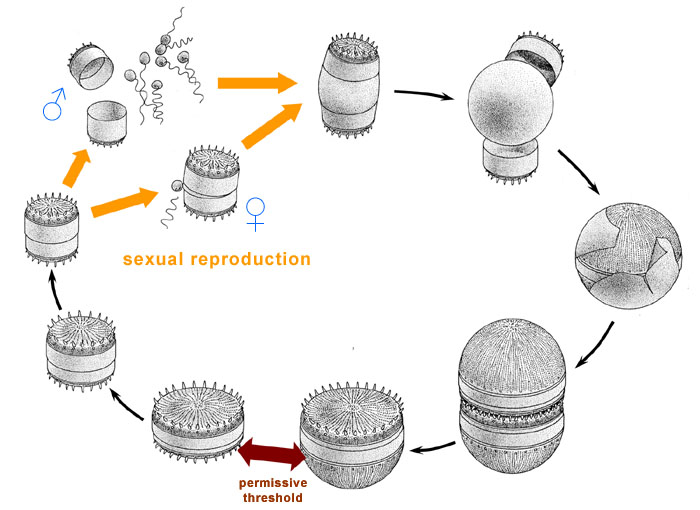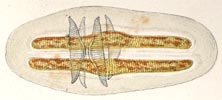
Life cycle of a centric diatom. II

The sexual phase
If the vegetative phase continued without interruption, cells would get smaller and smaller until they died. In culture, this often happens, which is one of the principal reasons why there are very few diatoms in culture collections. Most diatoms continue their life cycles via an obligatory sexual phase. During the formation of the gametes or soon afterwards, the cells slough off their cell walls, setting them free to expand. Meiosis takes place during the formation of the gametes, as in higher animals including humans.
Not all vegetative cells can differentiate to produce gametes: the largest cells are physiologically incapable of sexualization. Cells can produce gametes only after they have reached a critical size. After they have decreased in size below this threshold, gametes will be produced if particular other conditions are met (e.g. appropriate light or temperature or nutrient concentrations, or the presence of a compatible mate). The critical size is therefore only a 'permissive threshold'.
In the 'centric' diatoms (a paraphyletic group of basal lineages), sexual reproduction is oogamous, i.e. fertilization occurs between small motile sperm and larger immobile eggs, as in the illustration. Pennate diatoms, on the other hand, are usually isogamous, with similar large, non-flagellate, amoeboid gametes. In this case, there is often no differentiation into 'male' and 'female'.
The illustrations are modified by DG Mann from the originals used by Mann in Round et al. (1990, fig. 55)
References
Chepurnov, V.A., Mann, D.G., Sabbe, K. & Vyverman, W. (2004). Experimental studies on sexual reproduction in diatoms. International Review of Cytology 237: 91-154.
Round, F.E., Crawford, R.M. & Mann, D.G. (1990). The diatoms. Biology and morphology of the genera. Cambridge University Press, Cambridge.

 This site is hosted by the Royal Botanic
Garden Edinburgh.
This site is hosted by the Royal Botanic
Garden Edinburgh.